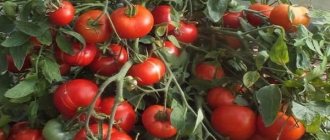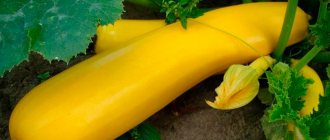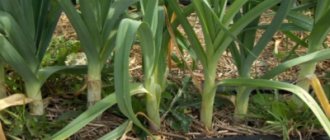Tomatoes for a greenhouse in the Urals: how to choose varieties
In order not to make a mistake with your choice, you need to find out in advance exactly which specific varieties of tomatoes are appropriate to plant in the Urals in a garden bed in a greenhouse. Tomatoes intended for the Ural regions must have certain characteristics that satisfy a number of important requirements:
- Have the ability to easily tolerate sudden changes in temperature. During the day, the greenhouse seriously overheats, sometimes to critical levels. At night, cooling inevitably occurs, which creates a stressful situation for the plants. Not every tomato variety is capable of setting fruit in such circumstances.
- Have low susceptibility to most typical diseases of nightshade crops. In a closed greenhouse space, optimal and most favorable conditions are created for the development of pathogenic organisms. Therefore, tomatoes grown in a greenhouse must have excellent immunity.
- It’s early (within 100 days) and together to give away the harvest. The bulk of the fruit should be collected before the onset of disease. In this way, you can avoid infection with the most common fungal pathology - late blight, which is especially important in the difficult climate of the Urals.
- Characterized by high yields so that all costs are recouped.
- It can withstand transportation well and has high shelf life.
As a rule, on the packaging of store-bought seeds there is always an indication of the possibility of growing specifically in the Urals. Such tomatoes are usually hybrid, zoned for the local difficult climate.
Tomatoes for a greenhouse in the Urals: the best early varieties
It is most logical, when selecting tomatoes acceptable for the Urals with the condition of placing them in a greenhouse, to focus on the earliest ripening ones, the best varieties of which are recognized as:
Krakowiak
Tomatoes for a greenhouse in the Urals.
Variety Krakowiak Super-early ripening (78-83 days), standard-shaped (no gartering or pinching required), small-leaved, determinate variety no more than half a meter high. Tomatoes of excellent taste with noticeable sourness, slightly flattened with barely noticeable ribbing, for salad purposes, weighing about 70-80 g. From 1 m2 it is possible to gain up to 3-4 kg.
Aphrodite F1
Tomatoes for the Urals for greenhouses.
Aphrodite F1 Dwarf bush (up to 0.35-0.55 m) with limited growth and medium-sized leaves. It branches quickly, therefore requiring attachment to supporting structures and the formation of a crown (ideal for the Urals). An early salad hybrid (75-80 days) with good taste, rather large (110-115 g), traditionally red dense fruits, characterized by excellent keeping quality.
Ultra early ripening
Tomato, variety Ultra early ripening
The plant is compact and low-growing (0.55-0.7 m), yielding a harvest 100-110 days later (up to 6.5-7 kg is harvested from 1 m2). A hybrid, non-prunable form with a friendly harvest of very tasty, glossy, smooth tomatoes of universal use, weighing 60-80 g (sometimes up to 100 g). To prevent heavy brushes from breaking off, they need to be fixed to a trellis or support installed in the greenhouse.
Alpha
Early tomatoes for a greenhouse in the Urals.
Variety Alpha Superdeterminate tomato variety of standard type (growth about 0.4-0.5 m), very early ripening (87-96 days) with potato-type leaf blades of medium size and regular dark green color. It is permissible to sow directly into the greenhouse, bypassing the seedling stage. Ripe tomatoes are smooth and elegant, weighing approximately 80-90 g, more suitable for fresh consumption. Marketable yield when maintaining agricultural technology is 6.2 kg/m2.
Yield tomatoes for a greenhouse in the Urals
Experience shows that even in not the most favorable climate it is possible to get a very decent tomato harvest. It is enough just to wisely choose the most productive and prolific varieties of tomatoes that are optimally suited for the Urals with localization in a greenhouse. Suitable:
Pudovik
Yield tomatoes for a greenhouse in the Urals.
Variety Pudovik Requiring formation (with the removal of lateral shoots) and mandatory tying to pins or stakes, indeterminate bush, more than 1-1.5 m in height, with large green leaves, mid-ripening (110-115 days). Heart-shaped, raspberry-red, brightly colored, juicy, fleshy and tasty, tomatoes are recommended both for salad consumption and for processing. Productivity - 15.5 kg/m2. In the State Register, the declared weight of one fruit is about 290 g, but in reality (especially in a greenhouse) it is much more - 0.8-1 kg.
Pink Elephant
Tomato variety Pink Elephant
Not too leafy, mid-early (112-115 days), growing up to 2 m (although considered semi-determinate) bush. Deep pink tomatoes, distinguished by excellent taste characteristics, large (280 g in weight), fleshy, flat-round in shape with a strongly ribbed base and notched top. Productivity - up to 8.2 kg/m2.
Pink icicle
High-yielding tomato variety Pink Icicle
Highly productive, ripening quite early (105-115 days), indeterminate, forming a large number of flower and fruit clusters (up to a dozen), tall (up to 1.8 m) variety, suitable for the Urals. Ripe tomatoes have a delicate salmon-pink hue, living up to their name, elongated shape, and excellent sweetish taste. It is often possible to collect up to 10 kg per plant, 110 g is the weight of one tomato.
Titanic F1
Tomato Titanic F1
Large-fruited (about 200 g), medium-term (110-113 days) from sowing to harvest, medium-sized, indeterminate hybrid, originally intended for greenhouses, as well as other protective shelters. A ripe fruit of a rich and familiar tomato red color, excellent taste, mainly used in salads in an unprocessed fresh form. The declared yield according to the State Register is 10 kg per plant.
Samara F1
Tomatoes for a greenhouse in the Urals.
Samara F1 Tall (2 m), medium branching and foliage, creeping, indeterminate, early ripening (94-118 days) variety. Ripe tomatoes are traditionally red, shiny, flat at the base, not prone to cracking, not too large (70-85 g), but on a bush (even in the Urals) there can be up to 9.7 kg/m2 per season. The taste is good.
Top 5. Siberian heavyweight
Rating (2021): 4.77
The early-ripening and large-fruited Siberian heavyweight embodied the dream of summer residents. They are low-growing, therefore require minimal care, ripen early and produce large tomatoes up to 800 grams.
- Characteristics
Ripening period: 85-100 days
- Fruit weight: 400-800 g
- Productivity: up to 3 kg per bush
- Bush height: 60-70 cm
In the “Siberian Heavyweight” the breeders managed to combine three qualities at once - early ripeness, short stature and large fruit. Thanks to them, gardeners in the Urals can grow a good harvest of tomatoes in open ground, which are in no way inferior in taste to mid-season and late greenhouse varieties. Sugar content, meatiness, juiciness and tenderness make the vegetable ideal for fresh salads, juices and use in homemade preparations. The bushes are not tall, but need support. Stepchildren can be left if you are not aiming for particularly large fruits. And in this variety they can grow up to a kilogram. Tomatoes often ripen on the vine even in cool summers. The Siberian selection variety is resistant to pests, diseases and even short-term frosts.
Advantages and disadvantages
- Tomatoes up to 800 grams
- Early ripeness
- Low growing variety
- Taste qualities
- Poorly stored
Buy on agrosemfond.ru
Tomatoes for the Urals for greenhouses: low-growing varieties
A guaranteed harvest, almost regardless of the weather, can be obtained from short and dwarf varieties of tomatoes, zoned for the Urals and suitable for planting in greenhouses:
Amber 530
Amber tomato 530
Yellow-fruited, low-growing 0.4 m, determinate, tomato that does not need to remove stepsons, but requires garter. Marketable yield is 2-2.7 kg/m2. The ripening period is 91-95 days. The fruits are usually flat-rounded, weighing about 80-85 g (often 120-150 g), good taste, eaten fresh.
Snubnosik
Tomato Snubnosik
Low (not higher than 0.5 m), super-determinate, bush with simple, medium-sized leaf blades of delicate light green shades. Very beautiful and attractive to look at, reddened ripe tomatoes are heart-shaped with a slightly blunt tip and ripen no later than 100-110 days. One fruit weighs about 150-200 g; its taste is rated “good.” From 1 m2 you can get up to 6.5 kg. You can plant not only in greenhouses, but also directly into the ground (even in the Urals).
Siberian Troika
Standard tomato variety Siberian Troika
Standard, powerful, stable, well-leafed, compact and low bush (0.5-0.6 m) with limited height growth (determinant). The variety is mid-ripening (up to 115 days), high-yielding (6 kg/m2). The tomatoes are cylindrical with a slightly elongated nose, weigh on average 200 g, and have an excellent sweetish taste.
Explosion
Tomato variety Explosion
Universal purpose, pleasantly early ripening (93-98 days), spreading, very low (0.5-0.6 m) variety of determinant type of development (steps moderately). Red, fully ripe tomatoes with pleasant roundness, weighing approximately 90 g. From 1 m2 it will be about 4-4.1 kg.
Doll Masha
Tomato Doll Masha
Limited growth, a determinate plant that needs to be moderately pinched in the greenhouse, stretching only up to 0.7 m. The hybrid bears fruit abundantly (8 kg/m2) and ripens well. The tomatoes are large (200-260 g) with weak ribbing, a beautiful even pink color and excellent taste (rated by expert tasters as the highest score - 5).
Who gets up early...
This section presents the best varieties of early ripening tomatoes, which are preferred by many summer residents of the Urals.
A standard tomato will “dance” a great dance for you in the form of a fruit harvest in the earliest possible time (80-83 days). The variety is recommended for open ground, does not require staking, supports, or pinching, that is, from the “plant and forget” category.
But you shouldn’t forget about care; after all, in a harsh climate you always need to be on guard. The fruits are round, weighing 60-70 grams, with very tender and tasty pulp.
The first fruits from a low bush of this tomato variety are harvested after 80 days. Aphrodite is a low-growing tomato (45-50 cm), does not need pinching, but requires a garter.
The round, red fruits weigh 100-110 grams. The pulp is juicy, fleshy, with a good “tomato” taste. From 1 sq. meters, 7-8 kg of fruit are removed.
This tomato is for the most impatient, as its fruits are harvested after 80-85 days. A low (45-50 cm) bush grows well in garden beds. Bred in Siberia, it adapts perfectly to the difficult climate of the Urals.
The fruits are dense, bright red, weighing 90-100 grams. Use – salads, preservation.
The standard bush of this variety grows up to 40 cm; pinching is not required. Productivity – 6-6.5 kg of fruits per square meter. meters.
Tomatoes are harvested early, already 85-90 days after emergence. The fruits are tasty, round in shape, weighing 70-80 grams, red in color.
The Alpha variety is not susceptible to late blight.
Tomatoes for the Urals for greenhouses: large-fruited
Huge meaty tomatoes are the cherished dream of any passionate vegetable grower. It is believed that the sweetest, most delicious and largest tomatoes can grow only under the hot southern sun. However, thanks to the tireless efforts of breeders, outstanding large-fruited tomato varieties have appeared, reaching maximum dimensions and suitable for the Urals (but suitable only for greenhouses):
Biysk rozan
Large-fruited tomatoes for the Urals for greenhouses.
Variety Biysky Rozan Self-limiting in growth, but at the same time requiring breaking off of excess stepsons and gartering, not too tall (0.75-1.1 m) plant. High-yielding tomato (4.6 kg/m2), for greenhouses, mid-early (110 days) with fleshy, voluminous, excellent taste, pink fruits, the weight of which, according to official data, is about 250 g, but in reality 0.5-1 kg ( and even 1.2 kg).
Berdsky large
Tomatoes for a greenhouse in the Urals.
variety Berdsky large Tomato variety, characterized by large fruit (0.7 kg) and yield (10-12 kg per m2). The bush is small (up to 1 m even in a greenhouse), semi-determinate (a garter is required, pinching up to the lower brush). Ripe tomatoes are pink-skinned, fleshy and sugary at the break, very tasty, ideally combining tomato sourness and sweetness. The ripening period is 105-110 days.
Abakan pink
Abakan pink tomato
An interesting salad variety for greenhouses with large (up to 0.5 kg) pink, flat-round or heart-shaped, good-tasting fruits that ripen in 110-120 days. Rarely exceeding 1.35-1.5 m in height, determinate (only a classic garter is needed), productive (4 kg/m2) bush.
Sugar Nastasya
Variety Sugar Nastasya
One of the most productive (from 1 m2 you can get up to 9-11 kg), medium-sized (1.5 m) indeterminate tomato for greenhouses, medium-late (120-130 days) ripening period, suitable for use in the Urals. An exclusively salad variety with large (0.25-0.3 or more), amazingly tasty, honey-like, low-seeded, red fruits.
Lemon giant
Large-fruited tomato variety Lemon Giant
Stable yield (6.1-6.7 kg/m2), salad, mid-season (109 days), indeterminate type tomato, stretching up to 1.5-2 m, requiring shaping and fixation to a support. The fruits are original yellow-lemon in color, very large (0.35-0.38 kg, sometimes up to 0.9 kg). The taste is excellent (five stars).
How to select and prepare seeds for planting
When choosing tomato seeds for the Urals, it is important to correctly read the information on the packaging, because the container itself is tightly closed and there is no other way to verify the quality of the seeds and their characteristics. Moreover, the reading should rather be between the lines, since when indicating the characteristics of the species, the manufacturer tries to smooth out the negative aspects as much as possible, covering them with insignificant or dubious advantages. Thus, the inscription “disease resistance” is essentially empty information, because it does not convey information about what diseases the plant is immune to.
“Good taste” indicates an unsuccessful hybrid with a large number of taste defects - so to speak, a product with a “C” grade. “Well transported” together with “not susceptible to cracking” - this is most likely a hard fruit, similar in density to an apple and with stringy, dry contents. The same applies to the high indicated shelf life of ripened fruits.
Even the most productive tomato varieties, which produce huge yields in southern latitudes, will disappoint the gardener of the Middle or Northern Urals. It is best to use selection specimens that have been tested in the area where they are planned to be grown.
Among such unpretentious and well-adapted tomato varieties for the Urals in the greenhouse are: “Yantarny”, “Zvezdochka”, “Ladoga”, “Nevsky”.
Seed preparation
If the gardener already has experience growing tomatoes and was pleased with the results from the previous harvest, it is best to use seeds collected by hand rather than purchased. To do this, ripe fruits are carefully selected from the strongest and healthiest bushes, and you need to take those that grew on the lowest clusters. Then the selected fruits can be removed to any place so that they can lie quietly until the tomato pulp liquefies.
Before sowing, in the spring, the seeds must be sorted, separating empty and low-quality grains. This is easy to do - dilute a 5% saline solution in a deep bowl, pour all the dried seeds into it and stir until they are well soaked. Those seeds that sink to the bottom of the bowl can be planted. The rest is collected from the surface of the water and thrown away.
See also
Characteristics and description of the tomato variety Star of SiberiaRead
The next stage is to inoculate the future plant with resistance to certain diseases, such as streaking. Such prevention is mandatory, since a tomato for the Urals in a greenhouse is exposed to many dangers that would be easier to combat in open ground.
Dressing is carried out as follows: 1 g of crystalline manganese is dissolved in half a glass of warm water and the seeds are introduced there for ten minutes. After the procedure, be sure to wash the seeds with settled water and dry them, spreading them in one layer on a napkin.
Hardening is one of the most important moments that determine the quality and volume of the future harvest. To do this, the grains are soaked in water at 18-21 C for two days, then they are transferred to ice water poured into a saucer and placed in the freezer. It is necessary to ensure that the temperature in the chamber does not fall below -3 C. After such preparation, the seeds for planting tomatoes in the Urals are ready for sowing in boxes.
Tomato varieties for greenhouses in the Urals, resistant to late blight
Among the best tomatoes, relatively immune to late blight (everyone gets sick, but to varying degrees), suitable for the specific conditions of greenhouses and suitable for growing in the cold Urals, the following varieties can be noted:
Rocket
Variety Rocket
Compact, sparsely leafed, small in size (0.4-0.6 m), determinate variety, allowing dense planting in greenhouses. The fruits are of good taste (score 3.8-4), with a retracted tip, red-scarlet, smooth, weighing about 34-58 g. Ideal for preservation in its entirety. The crop ripens en masse 122-129 days after sowing. Up to 9.5-10 kg/m2 - actual yield.
Semko 98 F1
Semko 98 F1
Yields after 85-120 days, early ripening, determinate, but not standard, semi-spreading, weakly branched and sparsely leafy, low (0.5-0.55 m) tomato with ordinary grayish-green leaves. In the Urals, about 3-6 kg of small (44-94 g), red, ripening, good-tasting fruits will be born per 1 m2.
Benito F1
Tomato Benito F1
Medium early (95-113 days), determinate, generously productive (5-6 kg/m2), fairly low-growing (not exceeding 0.5-0.7 m), strong, standard bush for greenhouses with large green foliage. No need for stepsoning. Ripe tomatoes weigh 40-70 g (sometimes up to 100 g), elongated, in the form of a small plum, excellent taste, regular red color.
De Barao
Tomato De Barao
A widely known and widespread indeterminate tomato variety, easily growing over 1.8-2.2 m (in a greenhouse and more than 3 m), voluminous and spreading, requiring constant pinching and a powerful garter. Universal purpose, reaching commercial ripeness quite late (115-120 days), with a declared yield of 5-6 kg/m2. The fruits are traditionally red, not too large (about 30 g), slightly elongated, plum-shaped, of excellent taste.
Verlioka F1
Tomato Verlioka F1
An early ripening (95-105 days) hybrid form that pleases with high (at least 4.5-5 kg per plant) yields in almost any weather, even in the Urals. Medium-sized (up to 1.5 m), semi-determinate, sparsely leafy tomato with densely spaced, picturesquely shiny, juicy red bright fruits (weight ranging from 90-100 g), with a pleasant slightly sweetish taste. Keeping quality is high, has no tendency to crack, and is transportable.
Alaska
Tomato Alaska
Determinate, beautiful and neat, low (0.5-0.7 m) bush, growing without formation in greenhouses. Red-colored, good-tasting fruits (85-94 g in weight) are ready for harvesting after 90-95 days. Exclusively salad consumption. From 1 m2 - about 9-11 kg.
Tomatoes for a greenhouse in the Urals: sweet varieties
Among the huge variety of varieties, gourmets can choose the most pleasant-tasting and sweet tomatoes, intended for greenhouses and fully ripening in the Urals:
Fairy gift
Tomato Fairy's Gift
For pickling, salad and canned purposes, determinate, orange-fruited, high-yielding (9.3 kg/m2), early (93-95 days) ripening tomato for greenhouses. Fixation to the support and shaping are required. The fruits have a specific gravity of 110-115 g, a beautiful heart-shaped shape and excellent taste with pronounced sweetness.
Superbomb
Tomatoes for a greenhouse in the Urals.
Variety Superbomb High-yielding (up to 7 kg per bush), compact and not too tall (0.8-1.5 m), determinate, ripening in the middle period (110-115 days). Tomatoes, covered with a delicate pink-red skin, weigh on average 160 g, but 300-600 g are not uncommon. The taste is at the highest level.
Barmaley
Tomato Barmaley
Determinate, pink-fruited hybrid of ultra-early ripening (98 days when planted in greenhouses). Attractively looking, slightly flattened, pink, moderately ribbed fruits (up to 200 g in weight) have a pleasant, pronounced sweetish taste.
Malachite Box
Malachite box
A tall (1.5-2 m) indeterminate plant that must be formed and tied up. Salad fruits are eaten immediately fresh, they ripen medium early (111-115 days), the usual yield is up to 15.1 kg/m2. Ripe, large (250-300 g), very beautiful tomatoes are extremely unusually colored (green with a pronounced yellow tint) and have emerald green flesh and an unusual sweet-melon taste (they have time to fully ripen and gain sweetness even in the Urals).
Elton John
Elton John f1
Standard, mid-ripening (107-116 days), low (0.45-0.5 m) plant with small dark green leaves, growing well in the Urals. Ripe tomatoes are yellow-skinned, weighing between 100-150 g, without sourness and very sweet (high carotene content). In a greenhouse with 1 m2 - 9 kg.
Pink honey
Variety Pink honey
Modest (up to 0.7 m) in size, determinate bush with large fruits weighing on average 160-200 g (the weight is often over 1.5 kg). Tomatoes with a large number of internal chambers, juicy, fleshy-dense, thin-skinned, with pronounced deep ribbing, pink in color and a pleasant honey taste. The yield declared by the State Register for greenhouses is 3.8-4 kg/m2, but in fact it is much higher.
Amur dawn
Tomato Amur Zarya
Successfully combining early ripening (105-110 days), large-fruited (100-120 g and up to 200 g) and increased yield (6.8-7 kg/m2) salad tomato for the Urals. Grown with moderate pinching, low (0.6-0.65 m), determinate bush. The inner pulp of the ripening fruits is extremely tasty, very sweet and tenderly fleshy, sugary-grainy at the break.
Top 4. Buffalo heart
Rating (2021): 4.82
The best combination of short stature and large fruit The breeders managed to achieve a combination of compact bushes and large fruit. The average weight of tomatoes is 400-600 grams.
- Characteristics
Ripening period: 100-117 days
- Fruit weight: 500-1000 g
- Productivity: up to 5 kg per bush
- Bush height: 70-80 cm
An interesting variety of Siberian selection is distinguished by a combination of short stature and large fruit. The maximum size of tomatoes is a kilogram. In open ground, tomatoes grow smaller - on average 400-600 grams. They resemble “Bull’s Heart” in shape and taste. They are just as fleshy, sugary, with thin skin and a small amount of seeds. They go great in salads, for making juices and sauces. It is possible to grow “Buffalo Heart” both indoors and outdoors. The height of the bush rarely exceeds 80 cm, but a garter is still needed. The weight of large, heavy tomatoes can cause branches to break. The fruiting period is extended. Tomatoes ripen gradually, until the first frost. Ripe fruits are stored poorly, but unripe ones are stored well.
Advantages and disadvantages
- Tomatoes up to 1 kg
- Sweet and meaty
- Extended fruiting
- High yield
- Low keeping quality
Buy on agrosemfond.ru
Varieties of cherry tomatoes for greenhouses in the Urals
Extremely cute tomato trees, dotted with clusters of fruits, are often used for purely decorative purposes. Adherents of exotic small-fruited tomatoes, the so-called cherry tomatoes, have a wide selection of varieties for the Urals with the possibility of cultivation in a greenhouse:
Yellow cap
Varieties of cherry tomatoes for a greenhouse in the Urals.
Yellow Cap An early ripening (85-90 days), self-forming in the form of a trunk, super-determinate, low-growing (0.3-0.5 m) bush. The fruit is smooth, round, soft to the touch, weighs no more than 15-20 g, and is characterized by excellent taste. The State Register for greenhouses states that the yield is 0.2-0.3 kg/m2.
Cherry Lisa F1
Cherry Lisa F1
Carpal type, early ripening (90-95 days) indeterminate (not higher than 1-1.2 m), productive (usually at least 10-12 kg per m2) small-fruited variety for the Urals. Ripe orange tomatoes, weighing 10 g, ripen almost simultaneously, do not crumble or crack on the bush.
parrot
Parrot F1
Red-fruited, early ripening (97 days), tall, medium-leafed indeterminate hybrid. Numerous (2.4-4 kg/m2), elegant, shiny, cherry-shaped, small red fruits weighing 20 g each, collected in a dense, abundantly branched cluster. Inside the pulp is sweet and tender, the taste is excellent.
Sweet bunch
Cherry tomato Sweet bunch
An extremely tall (more than 2.5 m) tomato, with unlimited growth, therefore it is necessarily formed and sprouted, reaching marketable ripeness early (90-100 days). Each very large cluster of fruit contains at least 20-50 small (20-30 g each), strong, sweet fruits of the usual red hue. Fruiting in greenhouses is very long, long-lasting and super-abundant (3.5 kg/m2).
Coin
Tomato Monetka
Extra early (85-90 days), small-growing, determinant type of development, grown without garter, standard tomato for the Urals. The tomatoes are small (up to 15 g), yellow-skinned, of good taste.
Don't forget the cherry crumbs
Gardeners' favorites are cherry tomatoes, with miniature fruits of different shapes and colors. For the Urals, we recommend hybrids and varieties that are resistant to the changeable local climate, productive and tasty.
An early tomato hybrid produces a large number of clusters, each containing 8-12 fruits. The bush is powerful, tall, and requires garter.
Tomatoes weighing 20-25 grams, round red cherries. The taste is excellent. Used fresh to decorate dishes and desserts. Productivity – 6 kg per 1 sq. meters.
A good choice for lovers of small-fruited orange tomatoes would be the Cherry Lisa hybrid. Resistant to diseases, this productive variety will give you tasty, slightly elongated tomatoes. Fruit weight is 15-25 grams.
Another cherry tomato that shows good results in greenhouses. Early ripening hybrid (80-85 days), up to a meter high. The brushes are complex, each with 6-7 tomatoes. The oval-shaped fruits are bright red, dense, and have good taste.
The weight of tomatoes is 18-20 grams. Ideal cherry tomato for canning and desserts.
![Tinkoff (Debit card) [CPS] RU](https://adzumi-sushi.ru/wp-content/uploads/tinkoff-debetovaya-karta-cps-ru41-330x140.jpg)










